The beauty of Rocky Mountain National Park
Posted!
A link has been posted to your Facebook feed.
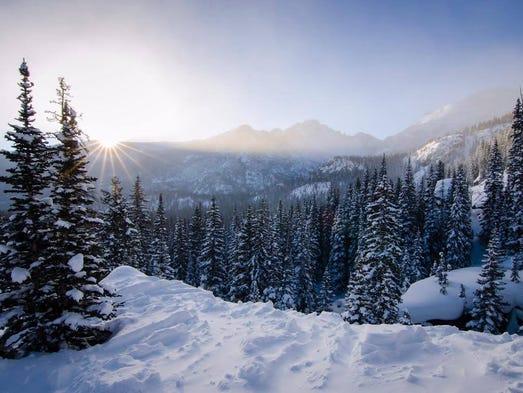
Enjoy the winter magic that is Rocky Mountain National Park! During this season, the park is transformed with snow and ice, trading in greens for a suit of white. Where is your favorite place to visit in winter?
Crystal Brindle, National Park Service
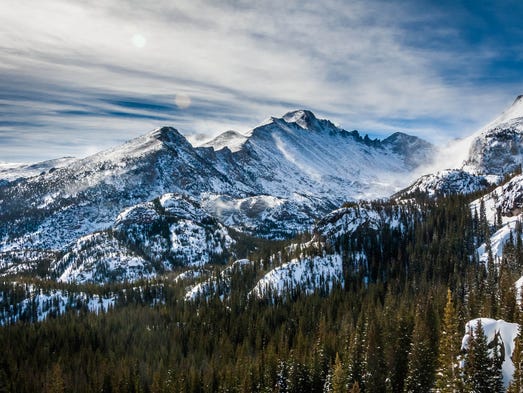
The winter view of Longs Peak from the Dream Lake Trail at Rocky Mountain National Park in Colorado is an epic sight. The wind kicks up a flurry of snow, sweeping the massive mountain and sending a chill we can feel through the screen. Does this make you want to put on your boots or slide under a blanket?
Brandon Selinsky, www.sharetheexperience.org
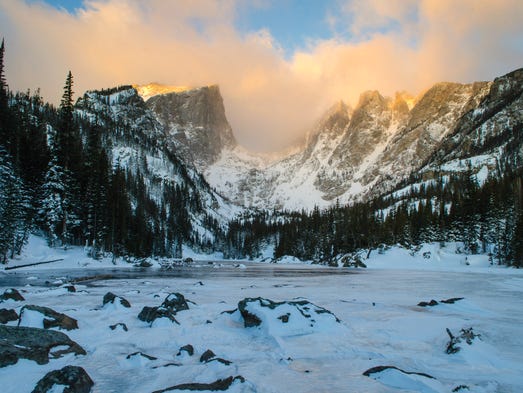
Offering a huge reward for little effort, Dream Lake is only a mile hike from Bear Lake Trailhead at Rocky Mountain National Park. Winter conditions can add complications, but there’s nothing like sunrise painting the mountains to make you forget about the cold.
Crystal Brindle, www.sharetheexperience.org

Designated as an All American Road, Trail Ridge Road crosses from beautiful pine forests to alpine tundra at some of the highest points in Rocky Mountain National Park. The drive is so high, that visitors will climb 4,000 feet in a matter of minutes! Outside of the car, plant and wildlife flourish throughout the drive -- moose, bighorn sheep and around 200 species of alpine plants are a few of the amazing sights that you might see. With a top altitude of over 12,000 feet, slow speeds and deep breaths are recommended.
Janine Dawley, www.sharetheexperience.org
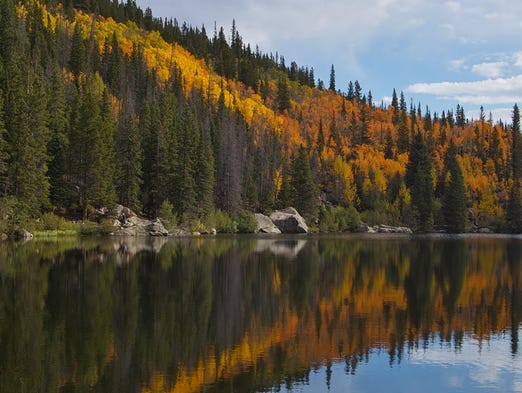
Autumn in Rocky Mountain National Park is crisp air, blue skies and generally dry weather. Aspen leaves start changing colors in mid-September, creating pops of gold and orange at higher elevations.
Karen Daugherty, National Park Service

Rocky Mountain National Park boasts epic views and amazing experiences. From Bear Lake, you can enjoy this vista of Longs Peak and the Keyboard of the Winds, an area of the park where wind channeled through the mountains and spires creates unearthly noises.
Jeff Stephenson, www.sharetheexperience.org
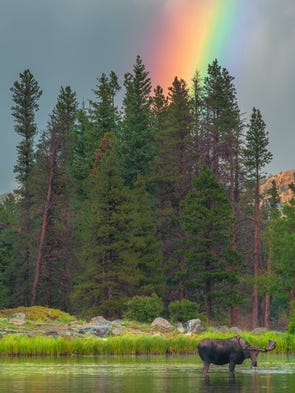
You never know what you’ll see at Rocky Mountain National Park. Emerging from cover after a storm, Ron Hazeloop chased a rainbow to Spruce Lake and just happened to catch a large bull moose standing in the water. Snapping the photo, he called it “a magical moment.”
Ron Hazeloop, www.sharetheexperience.org

Fall can come and go in the blink of an eye at Rocky Mountain National Park. This early fall picture captures the beauty of the park in autumn.
Vikas Garg, www.sharetheexperience.org
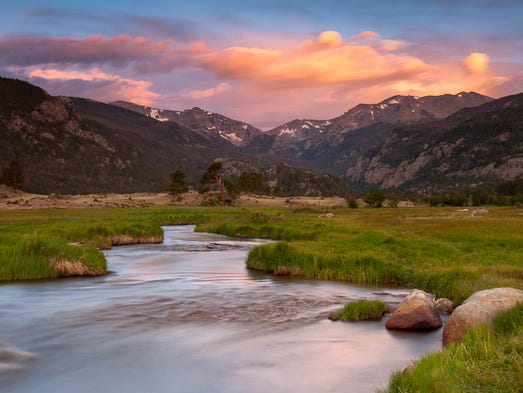
Moraine Park in Rocky Mountain National Park is an adventurer’s paradise. It offers beautiful views of the vast park and the surrounding mountains.
Nic Showalter, www.sharetheexperience.org
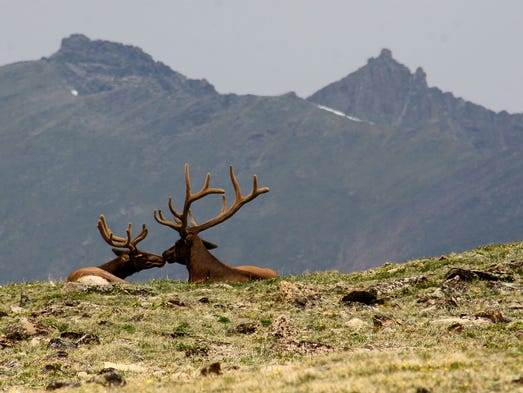
Every autumn, elk descend from the high country to montane meadows for the annual breeding season. Called rutting, bull elk compete with one another for the right to breed with a herd of females.
Brent Willmert, www.sharetheexperience.org
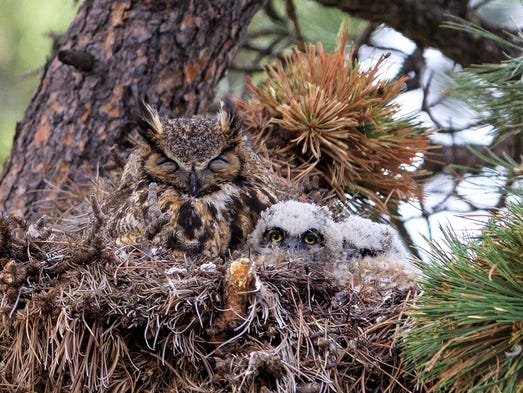
Over 270 species of birds have been reported in the Rocky Mountain National Park area over the past 100 years, including the great-horned owl. You’ll have to look closely to see the tired mamma as the two owlets peek over the nest’s top in Rocky Mountain.
Charles Jenkins, www.sharetheexperience.org

Rocky Mountain bighorn sheep are the largest wild sheep in North America. Muscular males can weigh over 300 pounds and stand over three feet tall at the shoulder. Females are roughly half this size. Bighorn sheep move to low elevations in Rocky Mountain in late spring and early summer.
Ann Schonlau, National Park Service
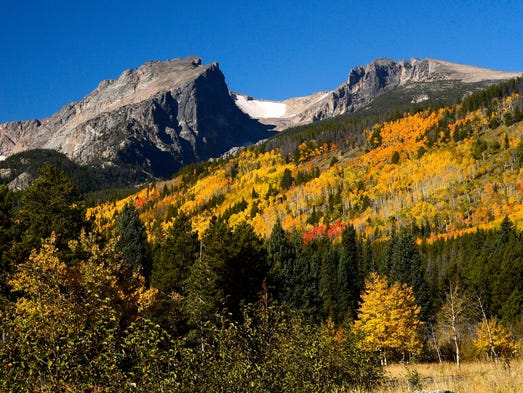
Rocky Mountain National Park is home to some of the highest mountains in the continental United States. The park includes 60 mountain peaks over 12,000 feet high and the Continental Divide, which runs north to south through the park.
Walt Kaesler, National Park Service
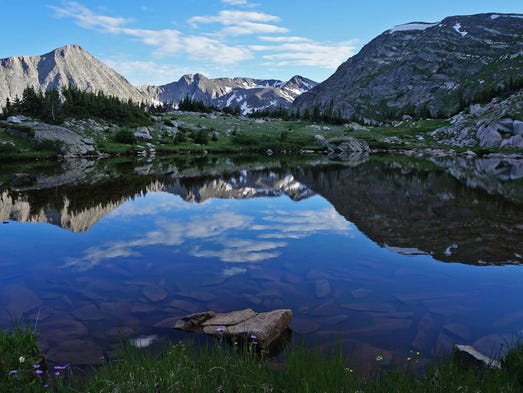
After a day of hike, sit on the banks of Gorge Lakes to experience the beauty in Rocky Mountain National Park.
National Park Service
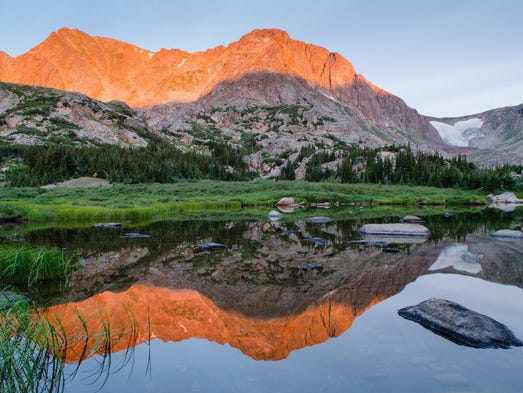
Reflecting lakes with towering peaks behind can make for amazing pictures at Rocky Mountain National Park. The still water becomes a mirror duplicating the skies above!
Crystal Brindle, National Park Service

Nearly 250,000 acres of Rocky Mountain is designated as wilderness, including the the Mummy Range area pictured here. With jagged peaks and fields of wildflowers, it’s a place of exceptional beauty.
Jim Westfall, National Park Service
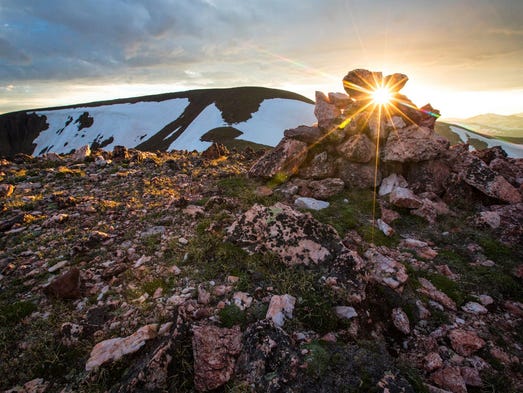
Sometimes it is about being in the right place at the right time to see nature's beauty revealed. There is always another breathtaking moments just around the corner at Rocky Mountain National Park.
Jacob W. Frank, National Park Service

When taking in the amazing views at Rocky Mountain National Park, don’t forget to look down! Summer is a great time to see wildflowers at the park, which is home to hundreds of different flower species. Wander through colorful mountain meadows and alpine wildflower hotspots like this beautiful rainbow bouquet at Upper Ouzel Creek.
Crystal Brindle, National Park Service
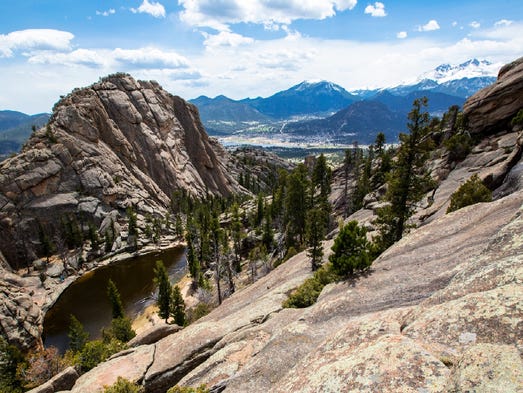
The shallow waters of Gem Lake are cradled high among the rounded granite domes of Lumpy Ridge at Rocky Mountain National Park. Untouched by glaciation, this outcrop of 1.8 billion-year-old granite has been sculpted by wind and chemical erosion into a backbone-like ridge.
Jacob W. Frank, National Park Service
Like this topic? You may also like these photo galleries:
Replay
Autoplay
Show Thumbnails
Show Captions
Over 250,000 acres of Rocky Mountain National Park offer some of the most gorgeous scenery in North America. If you can't get out into the wilderness just yet, though, the U.S. Department of the Interior has chosen some of their favorite Instagram shots of the national park (and find more on their instagram feed), just to tempt you into visiting. Looking for something even more wild? Scroll through the gallery below for Interior's picks from Denali National Park:
Denali National Park: Beautiful and wild
Posted!
A link has been posted to your Facebook feed.

Denali National Park and Preserve is six million acres of wild land, bisected by one ribbon of road. Travelers along it see the relatively low-elevation taiga forest give way to high alpine tundra and snowy mountains, culminating in North America's tallest peak. Called the Mountain by locals, Denali stands 20,310 feet tall.
Daniel A. Leifheit, National Park Service

Fall at Denali National Park and Preserve means gorgeous autumn colors and hungry brown bears. To get ready their long winter sleep, bears spend the summer and fall packing on the pounds -- gorging themselves on salmon, berries and grass. Sleeping snugly in their dens, breathing only once a minute and dropping their heart rate to 8-10 beats a minute, bears will live on their fat stores during the dark, cold winter.
Jacob W. Frank, National Park Service

Hundreds of glaciers flow across Denali, stretching from 19,000-feet to as low as 800-feet above sea level. The longest glacier in the park, the Kahiltna Glacier, stretches 44-miles long. Most of the glaciers are in the heart of the Alaskan range.
Victoria Field, www.sharetheexperience.org

Denali National Park and Preserve’s Wonder Lake hosts the closest campground to the Mountain, and even though it’s separated by nearly 26 miles, the sheer size of Denali gives campers impressive views.
Sherri Herdell Camperchioli, www.sharetheexperience.org

Fireweed blooms in the late Alaska summer and darkens as autumn approaches. It gets its name from growing on burnt ground left open after wildfires. One of the great joys of discovering the botany of Denali National Park and Preserve is the intact nature of the plant communities that exist here.
Gavin Danapong, www.sharetheexperience.org

A red fox walks near Highway Pass. The red fox is one of 39 species of mammals that scientists have documented in Denali National Park and Preserve.
Jacob W. Frank, National Park Service

An amazing pic of a moose enjoying the delicacies at Denali National Park in Alaska. Moose in the park tend to live in forested areas that are often close to lakes and marshes and other bodies of water. They graze on grasses, underwater vegetation, bushes, coniferous needles and deciduous leaves.
Jacob W. Frank, National Park Service

If you venture to Denali National Park and Preserve during the icy winter months, you may see an all-white snowshoe hare hiding quietly amidst the snow piles. This species gets its curious name from its very large hind feet that are lined with stiff hairs, forming a snowshoe to support its weight on the surface of the snow.
Tim Rains, National Park Service

Known around the world for its amazing scenery and wildlife, Denali National Park and Preserve is a place of excitement, inspiration, and exploration for travelers. Open year-round, activities at all levels of difficulty and exertion can be found. What will you do first when you visit?
Jeff Williams, www.sharetheexperience.org

Standing head and shoulders above the crowd, the Mountain dominates the landscape of central Alaska. On clear days, it can be seen from as far away as Anchorage and Fairbanks. Within Denali National Park and Preserve, however, it appears and disappears as the park road winds its way among the smaller mountains along the north edge of the Alaska Range. While clear skies are common in deep winter, summer skies are often cloudy.
Sandy Gagnon, www.sharetheexperience.org

The traffic is a little different in Denali National Park and Preserve. A bull caribou takes an evening stroll down the park road with Denali in the background.
Daniel A. Leifheit, National Park Service

Alaska is the most geologically active part of the country, and Denali National Park and Preserve reveals much of this activity. Immense tectonic forces wrinkle and crumple terranes to form the Alaska range that looks like a spiny backbone to the park. Denali towers over the landscape, and glaciers etch out the land. These are just a few of the amazing geological phenomena that occur in the park.
Tim Rains, National Park Service

You never know what you are going to see at Denali National Park in Alaska. Karl Persson captured this shot of a mama bear (with her two bear cubs in tow) knocking on a bus door.
by Karl Persson, www.sharetheexperience.org

In early winter dark skies descend on Denali National Park and Preserve in Alaska, leaving visitors in awe of the night sky. In this photo, the full moon rises over the park’s snow-covered mountains.
Katie Thoresen, National Park Service

Check out the fall colors from Denali National Park and Preserve. Termination dust -- the first snowfall that sticks to mountain tops and signals that winter is coming -- is visible on the Alaska Range in the background.
Michel Hersen, www.sharetheexperience.org

Summer sunsets at Denali National Park and Preserve in Alaska are truly special. Kent Miller snapped this dream-like photo of a moose walking along Reflection Pond. In the background, the top of Denali is illuminated by the setting sun at midnight.
Kent Miller, National Park Service

For seven months, Denali National Park gives visitors the chance to see the sky aglow with the beauty of the aurora borealis. This natural wonder is best seen from autumn to early spring when the sky is dark enough.
Kent Miller, National Park Service

Summer is the perfect time to visit Denali National Park and Preserve. If you’re lucky, you’ll have at least one clear, golden morning to see spots like Nugget Pond in all their glory.
Rebecca Latson, www.sharetheexperience.org

The Denali Park Road parallels the Alaska Range and travels through low valleys and high mountain passes. Along its route, beautiful landscapes can be seen at every turn, and there are many opportunities to view Denali (if the normally cloudy skies permit). Wildlife can often be spotted too, though sightings are not guaranteed -- they are, after all, wild animals roaming an unfenced land.
Tim Rains, National Park Service
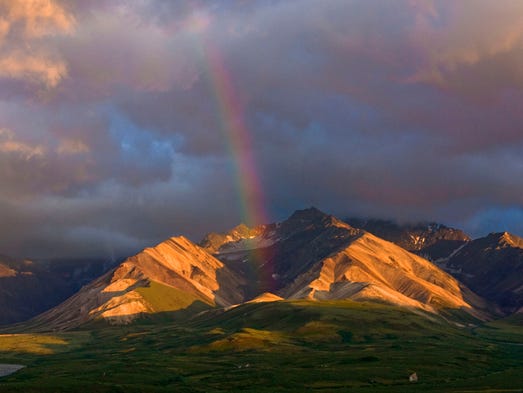
Denali National Park and Preserve in Alaska is 6 millions acres of wild lands with a single, 92-mile long road traveling through it. The places to go for adventure, solitude and recreation are nearly endless. Pictured here is a rainbow over Polychrome Overlook.
Ken Conger, National Park Service

Denali’s sled dogs have been a quintessential feature of the park, and they’re pretty darn cute! Sled dogs and rangers work together to protect the wilderness, often logging over 3,000 patrol miles. You can visit the kennels to see the dogs year round, though they’re often out and about in the park in the winter.
National Park Service
Like this topic? You may also like these photo galleries:
Replay
Autoplay
Show Thumbnails
Show Captions
Read or Share this story: https://usat.ly/2FOVz5c







































